
Sierra Leone
Country Flag Details
three equal horizontal bands of light green (top), white, and light blue; green symbolizes agriculture, mountains, and natural resources, white represents unity and justice, and blue the sea and the natural harbor in Freetown.
Background
The British set up a trading post near present-day Freetown in the 17th century. The colony gradually expanded inland during the course of the 19th century. Independence was attained in 1961. An authoritarian regime in the 1960s led to a lengthy civil war that ended in 2002, and the country has since conducted democratic elections.
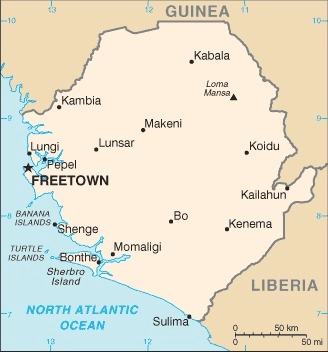
Geography
Area
total : 71,740 sq km
land: 71,620 sq km
water: 120 sq km
Climate
tropical; hot, humid; summer rainy season (May to December); winter dry season (December to April)
Natural resources
diamonds, titanium ore, bauxite, iron ore, gold, chromite
People and Society
Population
total: 9,121,049
Ethnic groups
Temne 35.4%, Mende 30.8%, Limba 8.8%, Kono 4.3%, Korankoh 4%, Fullah 3.8%, Mandingo 2.8%, Loko 2%, Sherbro 1.9%, Creole 1.2% (descendants of freed Jamaican slaves who were settled in the Freetown area in the late-18th century; also known as Krio), other 5% (2019 est.)
Languages
English (official, regular use limited to literate minority), Mende (principal vernacular in the south), Temne (principal vernacular in the north), Krio (English-based Creole, spoken by the descendants of freed Jamaican slaves; a first language for 10% of the population but understood by 95%)
Religions
Muslim 77.1%, Christian 22.9% (2019 est.)
Population growth rate
2.32% (2024 est.)
Government
Government type
presidential republic
Capital name: Freetown
Executive branch
chief of state: President Julius Maada BIO (since 27 June 2023) note – the president is chief of state, head of government, and Minister of Defense
head of government: President Julius Maada BIO (since 27 June 2023)
Economy
Real GDP (purchasing power parity)
$25.671 billion (2023 est.)
$24.284 billion (2022 est.)
$23.059 billion (2021 est.)
Real GDP per capita
$3,000 (2023 est.)
$2,900 (2022 est.)
$2,800 (2021 est.)
Exports
$1.304 billion (2023 est.)
$1.195 billion (2022 est.)
$1.114 billion (2021 est.)
Exports – partners
China 67%, India 6%, Belgium 5%, Netherlands 4%, Ireland 3% (2023)
Exports – commodities
iron ore, titanium ore, diamonds, aluminum ore, cocoa beans (2023)
Imports
$2.044 billion (2023 est.)
$2.013 billion (2022 est.)
$1.906 billion (2021 est.)
Imports – partners
China 32%, India 15%, UAE 5%, USA 5%, Turkey 5% (2023)
Imports – commodities
rice, plastic products, packaged medicine, cement, cars (2023)

Export structure by product groups in 2023 (% of total export) (UNCTAD)
The export structure of a country reflects the wide array and intrinsic value of its goods and services traded on the international market, providing significant insights into its overall economic health, competitive standing, and developmental stage. In Sierra Leone, the export landscape is predominantly characterized by mineral resources, which play a central role, while agricultural products and marine resources serve as important supplementary contributors. To strengthen resilience and achieve lasting and sustainable economic growth, it is imperative that Sierra Leone pursue diversification strategies. Nonetheless, the journey toward diversification is fraught with challenges, including inadequate infrastructure, restricted access to financial resources, and a pressing need for technological advancements, particularly within the agriculture and mining sectors, all of which serve as substantial barriers to progress in these diversification efforts.

Poverty and vulnerable employment in Sierra Leone (World Bank)
Understanding poverty level significance at $2.15
In 2018, 26 percent of the population in Sierra Leone lived in poverty at $2.15 per day. The poverty level at $2.15 per day (measured in 2017 purchasing power parity, or PPP) is a key global benchmark used by the World Bank to define extreme poverty in low-income countries. It indicates:
1. Basic Survival Threshold
• People living below $2.15 per day struggle to afford essential needs such as food, clean water, shelter, healthcare, and education.
2. Economic Underdevelopment
• A high percentage of a country’s population living below this threshold suggests low economic productivity, high unemployment, and weak social safety nets.
3. Inequality and Social Vulnerability
• It reflects deep income inequality and a lack of access to opportunities for upward mobility.
• People in this category are more vulnerable to shocks like food price increases, climate disasters, or health crises.
4. Policy Challenges
• Governments need targeted interventions such as social welfare programs, job creation, and improved access to education and healthcare to reduce poverty.
A country's export structure is a reflection of its level of development and productive capacities
The export structure of a country refers to the composition, diversity, and value of the goods and services it sells to other countries. It provides key insights into the country’s economic health, competitiveness, and level of development. Productive capacities of a country refer to its ability to produce goods and services efficiently and sustainably over time. These capacities are shaped by various factors, including human capital, natural resources, infrastructure, private sector, development, technology & innovation, institutions & governance, financial systems trade & market access.
Here’s what the export structure and productive capacities of a country typically indicate:
- Level of Economic Development
- Developed economies usually export high-value manufactured goods, technology, and services.
- Developing economies often rely on raw materials, agricultural products, or low-value manufactured goods.
- Industrial and Sectoral Strengths
- A strong presence of high-tech or industrial goods (e.g., machinery, electronics) suggests a well-developed manufacturing sector.
- A dominance of commodities (e.g., oil, minerals, agricultural products) indicates reliance on natural resources.
- Export Diversification
- A diverse export base (multiple industries) makes a country’s economy more stable and resilient to global price shocks.
- A concentrated export base (few key products) makes it vulnerable to market fluctuations.
- Trade Partnerships and Dependence
- If exports are heavily dependent on a single country or region, the economy is more exposed to geopolitical and trade risks.
- A wide range of trading partners indicates stronger global integration.
- Competitiveness and Value Addition
- Exporting mainly raw materials (e.g., crude oil instead of refined petroleum) suggests limited industrial processing capacity.
- A high share of finished and high-tech goods suggests strong value addition and competitiveness.
Sierra Leone-Sanitation
Sierra Leone – Proportion of population served with at least basic sanitation
In 2022, the proportion of the population served with at least basic sanitation for Sierra Leone was 22.9 %. Between 2000 and 2022, the proportion of the population served with at least basic sanitation of Sierra Leone grew substantially from 7.7 to 22.9 %, an absolute change of 15.2 percentage points (pp) between 2000 and 2022.
Sierra Leone – Proportion of urban population served with at least basic sanitation
In 2022, the proportion of the urban population served with at least basic sanitation for Sierra Leone was 34.5 %. The proportion of the urban population served with at least basic sanitation in Sierra Leone increased from 15.9 % in 2000 to 34.5 % in 2022, an absolute change of 18.6pp between 2000 and 2022.
Sierra Leone – Proportion of rural population served with at least basic sanitation
In 2022, proportion of rural population served with at least basic sanitation for Sierra Leone was 13.9 %. Between 2003 and 2022, the proportion of the rural population served with at least basic sanitation in Sierra Leone grew substantially from 3.1 to 13.9 % absolute change of 10.8 pp between 2000 and 2022.
Sierra Leone – Proportion of total population served with at least basic sanitation: A Global Perspective
The ongoing lack of safe sanitation represents a critical issue that demands immediate and concerted action, leading to the preventable deaths of hundreds of thousands of individuals every year and underscoring a significant public health crisis that must not be overlooked. Safe sanitation is not merely a basic necessity; it is an essential human right that every individual deserves access to without exceptions or excuses. In 2022, approximately 6.7 million people, accounting for nearly 77 percent of Sierra Leone’s overall population, faced the severe consequences of inadequate sanitation facilities, revealing a stark disparity when compared to other nations. For instance, countries such as Vietnam, China, and Thailand reported significantly lower figures, with only 8 percent, 5 percent, and a mere 1 percent of their populations lacking these vital services. Meanwhile, the global average of individuals without access to sanitation facilities hovers around 6 percent, emphasizing the urgent need to prioritize unity and collaborative efforts focused on enhancing sanitation access in countries across Sub-Saharan Africa that continue to be undeserved.

Sierra Leone – Proportion of rural population served with at least basic sanitation: A Global Perspective
In 2022, nearly 4 million people living in rural Sierra Leone, approximately 86% of that population, lacked access to basic sanitation facilities, highlighting a stark contrast when compared to countries like Vietnam, Sri Lanka, and Thailand, which reported access rates of only 12%, 5%, and 2% respectively. This critical shortage of safe sanitation is not only a pressing concern that demands our attention; it is a severe humanitarian crisis that necessitates swift and collaborative action, as this lack is responsible for the preventable deaths of countless individuals each year, revealing an urgent public health emergency that calls for our immediate empathy and action. Access to safe sanitation is a fundamental need and a basic human right that every person deserves, significantly enhancing the dignity and welfare of entire communities. Therefore, it is crucial for us to unite in our efforts to champion this vital right across Sub-Saharan Africa, where the need is most acute and the potential for impactful, positive change within local communities is immense, creating a setting where health and well-being can genuinely thrive for all.
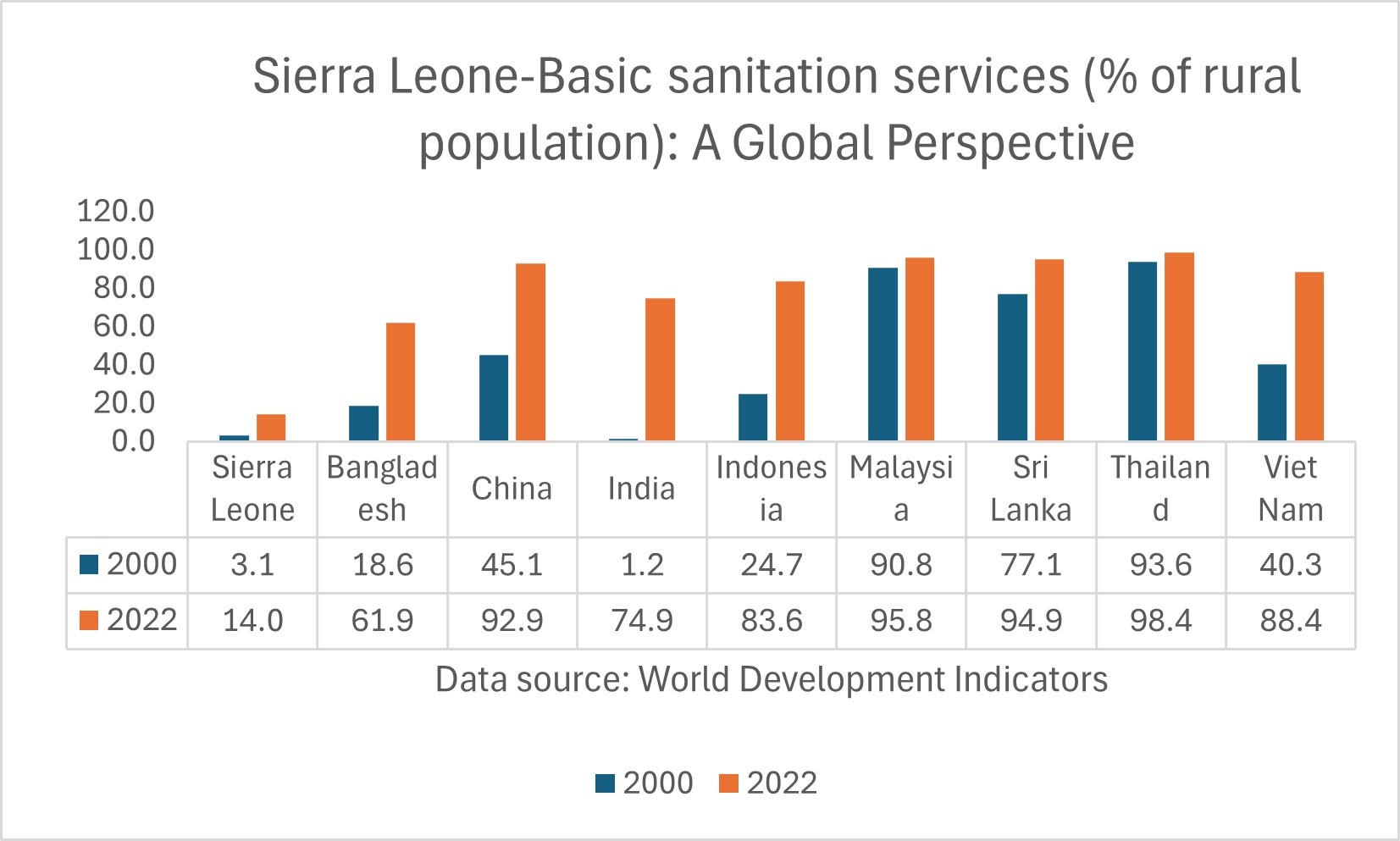
Sierra Leone-Water Supply
Sierra Leone – Proportion of total population served with at least basic water
In 2022, proportion of population served with at least basic water for Sierra Leone was 65.3 %. Proportion of population served with at least basic water of Sierra Leone increased from 41.1 % in 2000 to 65.3 % in 2022 an absolute change of 24.2pp between 2000 and 2022.
Sierra Leone – Proportion of urban population served with at least basic water
In 2022, proportion of urban population served with at least basic water for Sierra Leone was 79.8 %. Proportion of urban population served with at least basic water of Sierra Leone increased from 67.2 % in 2000 to 79.8 % in 2022 , an absolute change of 12.6pp between 2000 and 2022.
Sierra Leone – Proportion of rural population with at least basic water
In 2022, proportion of rural population served with at least basic water for Sierra Leone was 54.1 %. Proportion of rural population served with at least basic water of Sierra Leone increased from 26.6 % in 2000 to 54.1 % in 2022 , an absolute change of 27.5 pp between 2000 and 2022.
Sierra Leone – Proportion of total population served with at least basic drinking water: A Global Perspective
Access to safe drinking water is not merely a fundamental human need; it is an essential human right that profoundly influences health and overall well-being. Alarmingly, in 2022, nearly 3 million individuals in Sierra Leone were deprived of reliable access to safe drinking water, accounting for approximately 35 percent of the nation’s population. This troubling reality highlights the severe challenges related to water infrastructure and accessibility that persistently afflict the country and hinder progress in public health. In sharp contrast, nations like Thailand, Vietnam, and Bangladesh have made significant strides in providing their populations with access to safe drinking water, with Thailand achieving a remarkable 100 percent coverage and both Vietnam and Bangladesh extending this crucial resource to 98 percent of their citizens. The glaring disparity in water access not only emphasizes the urgent need for addressing water access issues across different countries of Sub-Saharan Africa but also reinforces the idea that every individual deserves the right to safe drinking water. Upholding this right universally is essential not only to enhance public health but also to promote social equity and ensure that every community can thrive in the face of existing challenges.

Sierra Leone – Proportion of rural population served with at least basic water: A Global Perspective
In 2022, a staggering 46% of Sierra Leone’s rural population, which equates to approximately 2 million individuals, encountered a severe and alarming lack of access to safe drinking water, underscoring a critical public health crisis that profoundly affects the daily lives and overall well-being of countless families across the nation. This distressing situation stands in stark contrast to countries like Thailand, where an extraordinary 100% of rural citizens benefit from dependable access to safe drinking water, and neighboring nations such as Vietnam and Bangladesh proudly achieve impressive access rates of 98%. These glaring disparities not only highlight the immediate need for substantial and compassionate reforms within the governance structures of Sub-Saharan African countries but also emphasize the vital importance of improving living standards for their citizens. Moreover, it is essential to guarantee that every individual has equitable access to fundamental resources like clean drinking water, as is illustrated in the accompanying chart, which paints a clearer picture of these critical issues that demand urgent attention and action.

Sierra Leone-Access to electricity
Sierra Leone-Access to electricity (% of population)
In 2022, proportion of population with access to electricity for Sierra Leone was 29.4 %. The proportion of population with access to electricity of Sierra Leone increased from 7.7% in 2000 to 29.4% in 2022, an absolute change of 21.7pp between 2000 and 2022.
Sierra Leone-Access to electricity (% urban population)
In 2022, proportion of urban population with access to electricity for Sierra Leone was 55.3%. The proportion of urban population with access to electricity of Sierra Leone increased from 23.6% % in 2000 to 55.3% in 2022, an absolute change of 31.7pp between 2000 and 2022.
Sierra Leone-Access to electricity (% rural population)
In 2022, proportion of rural population with access to electricity for Sierra Leone was 5 %. The proportion of rural population with access to electricity of Sierra Leone increased from 4.7% % in 2020 to 5% in 2022, an absolute change of 0.3 pp between 2020 and 2022.
Sierra Leone-Proportion of total population without access to electricity: A Global Perspective
In 2022, a staggering 77 percent of the population in Sierra Leone lacked access to electricity, translating to nearly 7 million individuals in Angola who are deprived of this essential service, which is crucial for improving their quality of life and economic opportunities. This dire situation stands in stark contrast to Thailand, where an admirable 100 percent of the population enjoys reliable access to electricity, and countries like Vietnam and Bangladesh follow closely with impressive access rates of 98 percent, showcasing the advancements made in these regions. On a global scale, the average electricity access stood at 91.4 percent, underscoring the urgent and critical need for transformative governance reforms across Sub-Saharan Africa that can significantly enhance the living conditions for its citizens, bridge the vast disparity in energy access, and pave the way for sustainable development initiatives that empower communities and foster equitable growth, ultimately creating a more just and sustainable future for all.
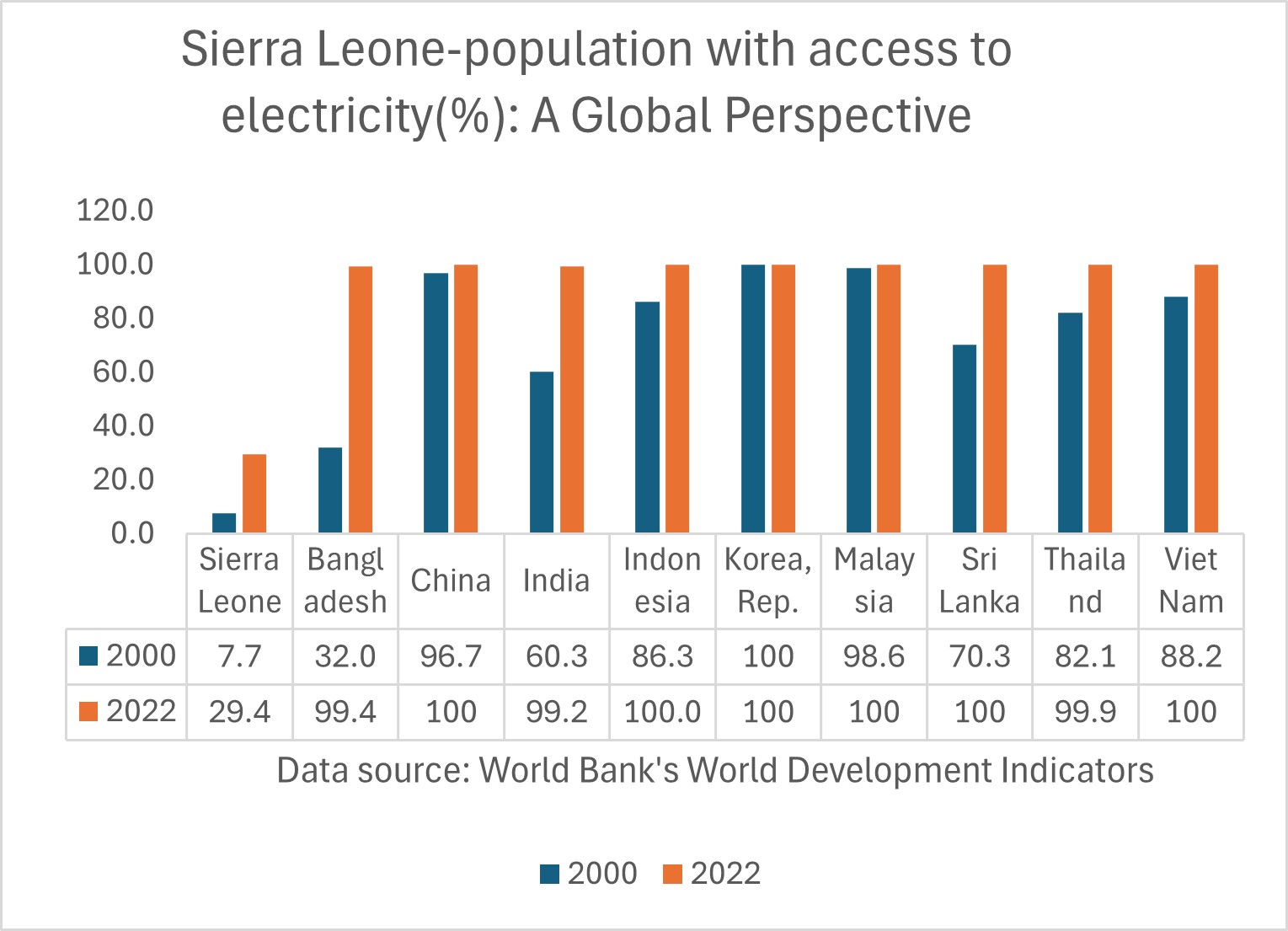
Sierra Leone-Proportion of rural population without access to electricity: A Global Perspective
In 2022, an alarming 95% of the rural population in Sierra Leone, which amounts to approximately 4.6 million individuals, faced the relentless challenge of living without electricity, a vital necessity for modern existence and development. This disheartening situation stands in stark contrast to the complete access to electricity that rural communities enjoy in countries like Vietnam, Sri Lanka, Thailand, and China, where every individual benefits from dependable power sources. Even neighboring nations such as India and Bangladesh can boast an impressive 99% of their rural populations with access to electricity. These significant disparities underline the pressing need for comprehensive structural reforms across Sub-Saharan Africa, focused on improving living standards and rekindling hope for countless families who aspire to a brighter, more promising, and sustainable future for themselves and their children, as they seek to break free from the cycle of poverty and enhance their quality of life in an increasingly interconnected world.

Sierra Leone- Health outcomes
Sierra Leone-Life expectancy: A Global Perspective
In reflecting on life expectancy trends over the past seven decades, we observe a remarkable and encouraging global transformation, as people everywhere are experiencing longer lives than ever before. In 1950, the average life expectancy for a newborn was merely 47 years, yet by 2021, this figure had risen significantly to 71 years, indicating substantial progress in many regions of the world. However, the advancements have not been equally felt, particularly in numerous Sub-Saharan African countries where improvements remain modest. For instance, in Sierra Leone, life expectancy has grown from just 34 years in 1960 to 60 years in 2022, highlighting the persistent challenges. In stark contrast, South Korea’s experience has been one of remarkable growth, witnessing an astounding increase from a mere 54 years in 1960 to 83 years in 2022, while the Maldives also saw significant progress, with life expectancy climbing from 39 years in 1960 to 81 years in 2022. These disparities underscore the urgent need for improved access to essential resources, as such necessities are crucial for enhancing the quality of life for individuals in these impacted regions.
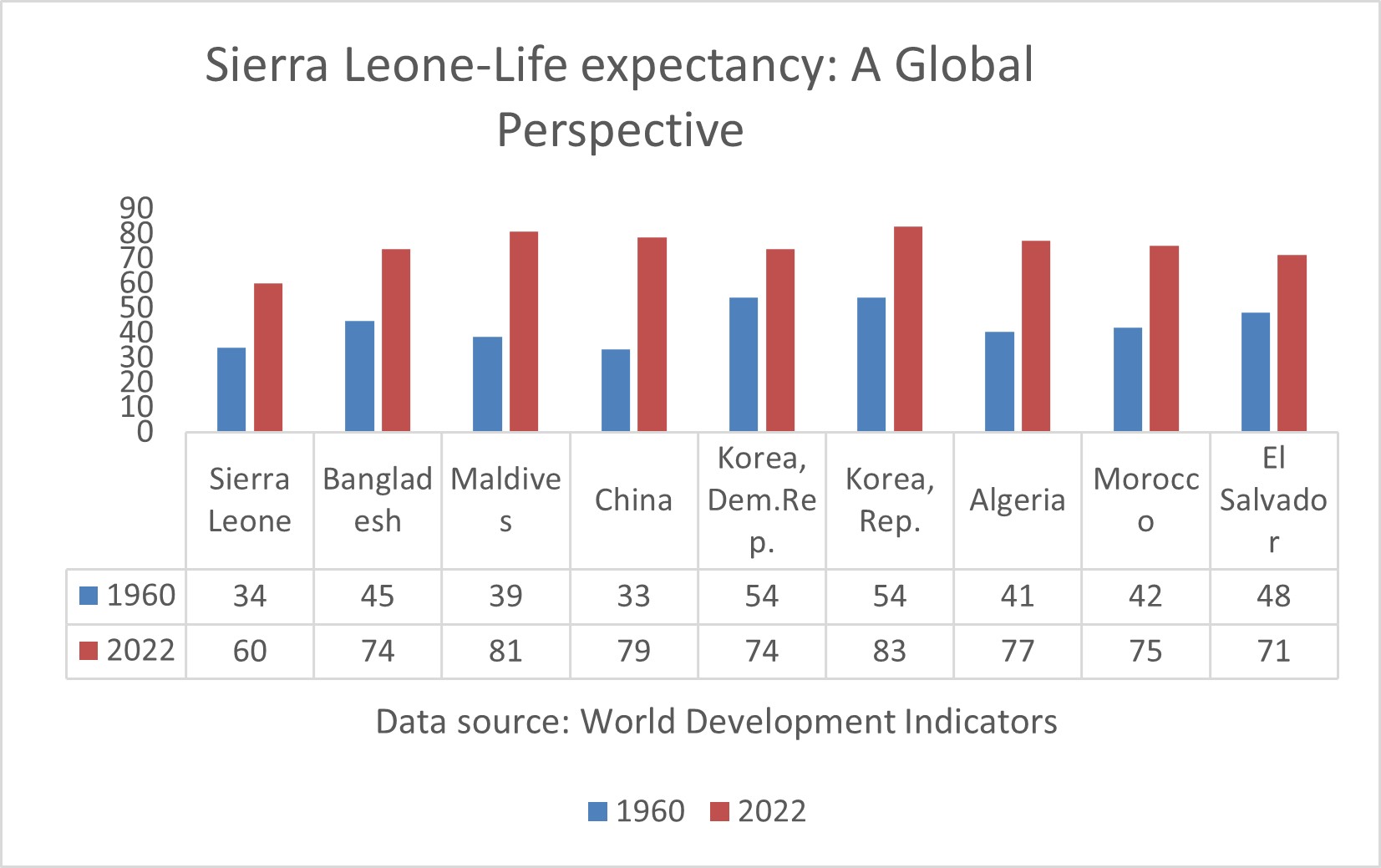
Sierra Leone-Mortality rate, under-5 (per 1000 live births): A Global Perspective
Since 1950, the global landscape of child mortality rates has undergone a remarkable transformation, largely driven by significant advancements in living standards, improved access to healthcare, enhanced nutrition, and the provision of safe drinking water. In the wealthiest nations, particularly across Europe and America, child mortality rates have impressively fallen to below four percent, reflecting the profound impact of these developments. Over the past seven decades, many developing countries throughout South America, Asia, and Africa have made notable strides; however, the pace of progress in most Sub-Saharan African nations has remained alarmingly slow. For instance, in Sierra Leone, the under-five mortality rate has seen only a modest reduction, decreasing from an alarming 288 deaths per 1,000 live births in 1960 to 101 in 2022. In stark contrast, Bangladesh has achieved a remarkable decline in its under-five mortality rate, plummeting from 206 in 1980 to just 29 in 2022, while India has similarly reduced its child mortality rate from 169 to 29 during the same timeframe. These disparities highlight the formidable challenges posed by inadequate and underfunded healthcare systems that persist in Sub-Saharan Africa, underscoring the urgent need for comprehensive interventions and support to bridge the gap with other developing regions.
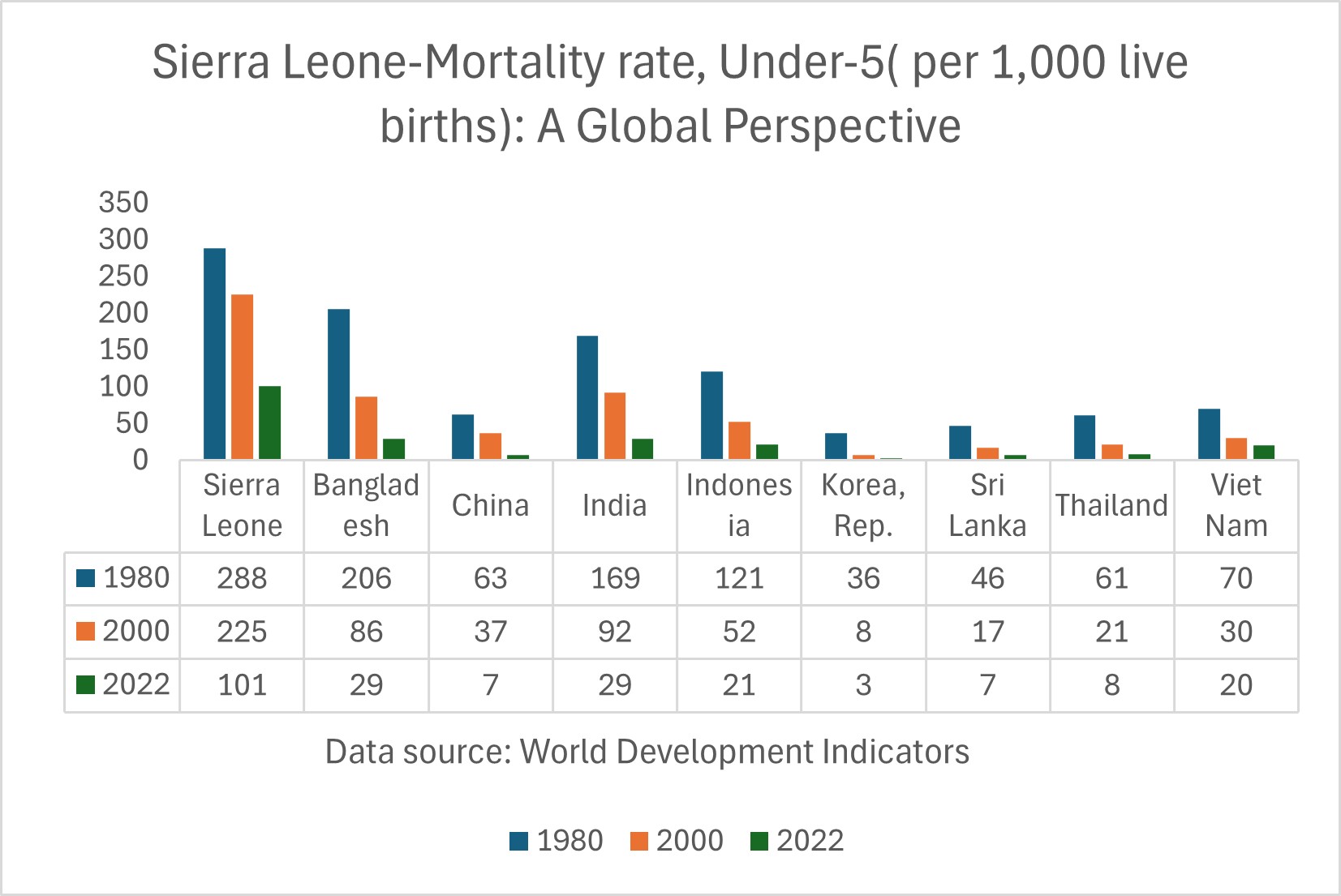
Sierra Leone-Maternal mortality ratio (per 100,000 live births): A Global Perspective
The statistics presented below illuminate the annual incidence of pregnancy-related deaths in developing countries, drawing particular attention to the profound sorrow experienced in Sub-Saharan Africa. This region, defined by its alarmingly high birth rates, confronts the harsh reality of significantly elevated maternal mortality rates that urgently demand our attention and action. For example, in 2020, Sierra Leone recorded an astounding 443 maternal deaths, a heart-wrenching figure that starkly contrasts with the considerably lower numbers reported by Vietnam, Thailand, Sri Lanka, and India, which saw only 46, 29, 29, and 103 deaths respectively. These distressing statistics not only underscore the urgent need for improved healthcare systems but also reveal the significant governance challenges faced by numerous nations in Sub-Saharan Africa that hinder progress. This dire situation highlights the essential requirement for compassion, empathy, and sustained support for those affected by these tragic losses, reinforcing our shared responsibility to confront these critical issues and actively strive for a more equitable future for all mothers and their newborns.
